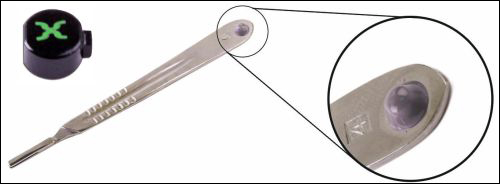Oct 27, 2015RFID technology company Xerafy has announced the release of two on-metal tags that are no bigger than a grain of rice—tiny enough to be embedded in, or attached to, objects such as surgical and dental tools, in addition to very small automotive components. The Dash XXS and Dot XXS are what Xerafy calls the world's smallest RFID metal tags. Both can sustain high temperatures, making it possible for them to be used in sterilization and autoclave environments. They were designed for the health-care industry, says Dennis Khoo, Xerafy's CEO, as well as for use in the automotive manufacturing and oil and gas industries.
Xerafy plans to begin shipping the tags to customers by mid-November.

Three years ago, Khoo says, Xerafy released the larger versions of the tags, the Dash XS and Dot XS models, both of which proved to be highly popular, he reports. Nonetheless, the company continued trying to develop something smaller. "One of the applications was for surgical tools," he notes, and the XS tags, though small, are about twice the size of the new XXS tags, making them too large for some surgeons who handled the tools. The concern was that the XS tags or equivalent could add weight, upset the tool's balance and make it that much more difficult for physicians to manipulate them while performing surgery on a patient. Some items, such as certain dental tools and automotive components, were too small to be fitted with an XS tag.
According to Khoo, the XXS versions—which have been tested in trials by multiple customers during the past six months—are small enough that they can be manufactured directly into very small items. Both the Dash XXS and Dot XXS tags are made with an Alien Technology Higgs-3 chip and encased in ceramic material, thereby ensuring that they can operate well when attached to metal. The Dash XXS weighs 0.004 ounce (0.12 gram) and measures 6.75 millimeters by 2.08 millimeters by 2.08 millimeters (0.26 inch by 0.08 inch by 0.08 inch). The tag can be read at a distance of up to 2 feet via a fixed reader with a linearly polarized antenna.
The Dot XXS is even smaller, weighing 0.006 ounce (0.16 gram) and measuring 4.08 millimeters (0.16 inch) in diameter and 2.58 millimeters (0.10 inch) in thickness. It has a read range of up to 1.6 feet (0.5 meters) with a fixed reader.
Both tags can sustain chemical sterilization, thermal disinfection at temperatures of up to 77 degrees Celsius (170.6 degrees Fahrenheit) for at least 30 minutes and sterilization at 135 degrees Celsius (275 degrees Fahrenheit). Both have also passed Xerafy-conducted tests for autoclave sterilization at 121 degrees Celsius (250 degrees Fahrenheit) for 1,000 cycles.
The challenge in developing the new tags was not only to shrink them to about half the size of the XS models, says Moses Chang, Xerafy's sales and marketing manager, but also to maintain a reasonably long read range. "We brought it to market, patented our design, and that's where we excel," Chang says, referring to the company's ability to create ceramic, on-metal tags in small form factors.
Chang reports that Xerafy will continue to sell its existing XS tags to end users that don't need the extremely small form factor and want the added read distance. The Dash XS, for instance, has a read range of up to 6.6 feet (2 meters) but is sized at 12.3 millimeters by 3.0 millimeters by 2.2 millimeters (0.5 inch by 0.1 inch by 0.09 inch). The Dot XS can be read at a distance of up to five feet (1.5 meters) with a diameter of 6.0 millimeters (0.2 inch) and a thickness of 2.5 millimeters (0.1 inch).

Initially, the XXS tags will be about 10 to 20 percent more expensive than the XS versions, Khoo says. However, he predicts the price will drop with higher-volume production.
The customers that have already piloted the XXS tags include health-care providers, automotive manufacturers, and oil and gas companies. In the case of health care, the tags were attached to surgical instruments, and were put through numerous washing and sterilization cycles. "The feedback was phenomenal," Khoo states. Several of those customers, which have asked to remain unnamed, are now using the tags as part of a permanent deployment.
The automotive manufacturers are attaching the tags to very small components used during the manufacturing process. In the oil and gas sector, the tags are being applied to items such as frac iron. Data about an asset's use and manufacturing date can be written to its tag's 512 bits of user memory, or be linked to that tag's unique ID.
In the case of hospitals and other health-care end users, Khoo says, many had previously opted not to adopt RFID technology because the tags would not fit on their smallest tools. If the tags fit on only 60 percent of their tools, he explains, these organizations didn't see the value in a partial deployment. "For RFID to be really effective," he says, "they would want to tag as many instruments as possible." The XXS can be applied to most surgical tools, including the smallest ones.
Companies are also testing the XXS tag on surgical implants, and then tracking them from the point of arrival at a facility until their implantation in a patient, at which point the tag is removed. In addition, Khoo says, the tags are being tested on small dental instruments that undergo multiple sterilization processes.
The tags can be used not only for asset management, but also for tracking every item's life cycle. This can be accomplished by reading the tag each time an object is sterilized or used on a patient.
Khoo believes the new XXS tags are likely to be used for a variety of applications beyond surgical tools, automotive and oil and gas. He predicts that they will be of particular use to companies that may not have used RFID previously because "they felt it would interfere with the integrity of the object, or it would create an obstruction."
While Xerafy is in discussions with companies that vary from manufacturers to end users of a product that could be tagged, one common application will be to embed the XXS tags at the point of manufacture, since they are small enough to be easily included in the manufacturing process, and built-in tags will not necessarily be highly visible to users. In some cases, however, product users or manufacturers may want to add a visible label to identify the tag's location, Khoo notes, since such visibility would make it easier for users to locate the tag in order to better read it. "Depending on the manufacturer, we are working with their marketing teams," Khoo says, adding that his company has learned from its customers' marketing personnel that "the tag becomes a brand for them," and that a sticker or label thus helps advertise the built-in tag's presence.
Xerafy is presently working with partners that include those already providing software solutions for the health-care market that might not have previously offered RFID technology, as well as systems integrators for the pharmaceutical industry. Other partners include manufacturers that wish to offer the RFID functionality to customers of their products.



